Protein Powders vs Protein Bars: Which is Best?
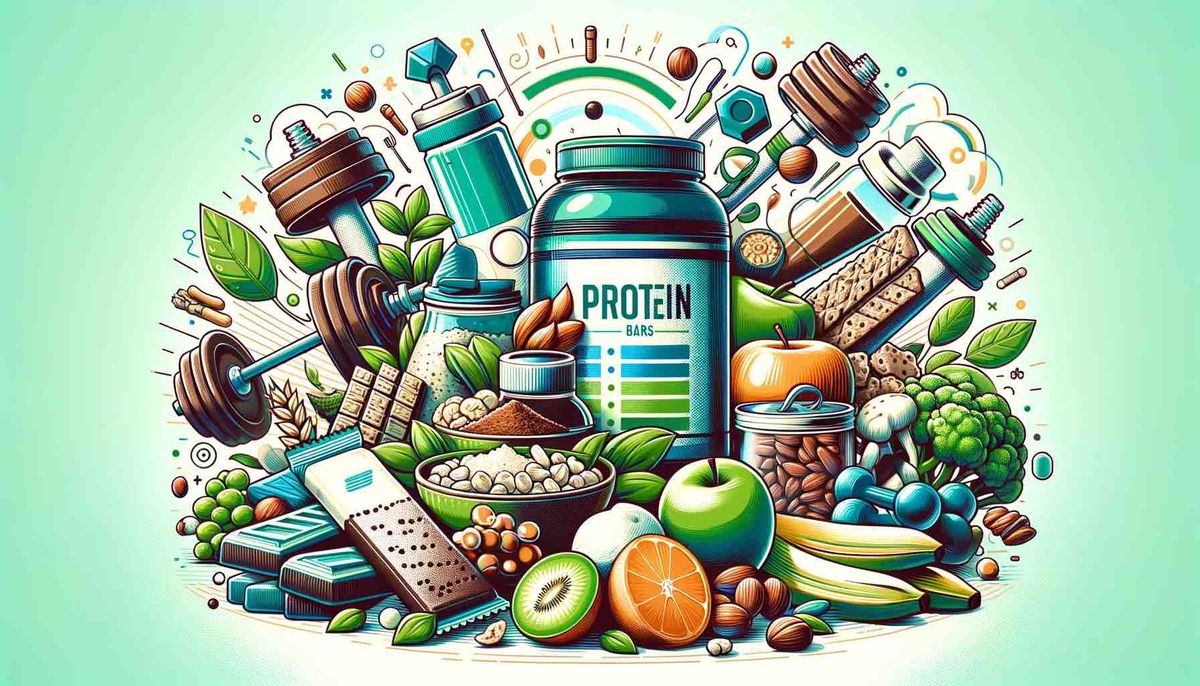
I lift most days and am training to run 100 km at the end of the year, so not a day goes by without me thinking about protein.
If you train a lot, too, perhaps you're the same? I try to get a decent amount of protein from real foods, but it can be challenging, so I rely heavily on protein powder. I use it to make shakes, smoothies, porridge, and pancakes—and I even have it in my cereal. I also use bars when I travel, as they're a convenient way of increasing my protein intake without a shaker or blender.
Let's look at how much protein is in powders and bars, how well they support goals like muscle growth, muscle repair, and weight loss, and options for those concerned about sweeteners and added sugar.
How Much is Enough Protein?
According to the Mayo Clinic, those who lift frequently or are training for an endurance event should aim for 1.2–1.7 grams of protein per kilo of body weight per day (i.e., about 0.5–0.8 grams per pound of body weight). For instance, an 85-kilo person (the average weight of a man in the UK) would aim for 102–145 grams per day, while a 72-kilo person (the average weight of a woman in the UK) would aim for 86–122 grams per day.
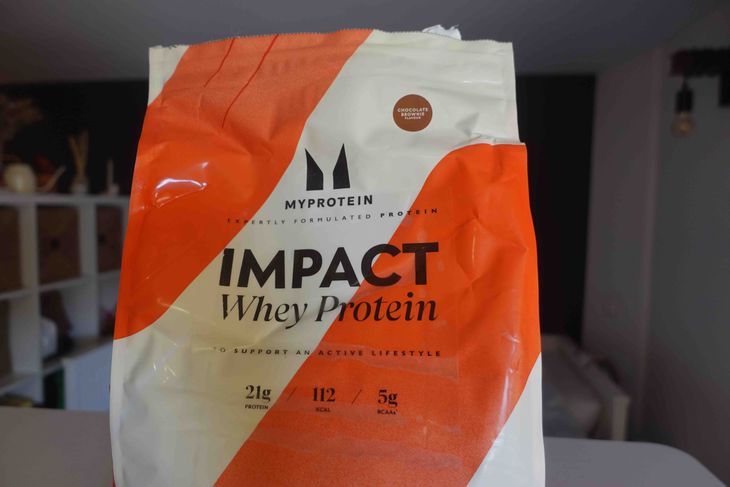
My current bag of whey protein concentrate from Myprotein. I usually go for vanilla as it mixes well with a lot of different flavours, but I went for a chocolate brownie flavour last time as it was a bit cheaper. It has a little less protein than vanilla, but it makes a nice change and goes well in smoothies with bananas and peanut butter. According to the ingredient list, it contains: "Whey Protein Concentrate (Milk) (89%) (contains Emulsifiers (Soya Lecithin, Sunflower Lecithin)), Fat Reduced Cocoa Powder, Flavouring, Sweetener (Sucralose)."
Protein Content in Protein Powder and Bars
Protein Powders
The amount of protein in a protein powder depends on how pure the powder is (e.g., a concentrate vs. an isolate) and on the source of protein. The main milk-based proteins are whey and casein. As you can see in Table 1, these tend to provide between 60 and 90 grams of protein per 100 grams (about three scoops).
Table 1
Calories and Grams of Protein, Carbs, and Fats in 100 Grams of Milk-Based Protein Powders From Myprotein, Grenade, and Bodybuilding Warehouse
| Supplement | Calories | Protein | Carbs | Fats |
| MP Whey Concentrate | 405 | 77 | 8.3 | 7.1 |
| MP Whey Isolate | 359 | 81 | 4.6 | 1.1 |
| MP Diet Whey | 349 | 61 | 13 | 4.1 |
| MP Total Protein | 388 | 81 | 4.4 | 4.9 |
| MP Casein Powder | 350 | 82 | 4.7 | 1.2 |
| Grenade Whey Protein | 370 | 78 | 1.9 | 1.8 |
| BW Whey Concentrate | 375 | 80 | 4.7 | 5.7 |
| BW Whey Isolate | 374 | 90 | 1.0 | 1.0 |
| BW Pure Casein | 375 | 78 | 13.1 | 1.1 |
| BW Casein Hydrolysate | 320 | 85 | 0 | 0 |
To learn more about these milk-based proteins, check out my article comparing whey and casein protein powders.
The main plant-based sources of protein include pea protein, soy protein, hemp protein, and rice protein. You can also get vegan blends that combine various types of plant-based proteins. As shown in Table 2, plant-based protein powders tend to provide between 50 and 90 grams of protein per 100 grams (about three scoops).
Table 2
Calories and Grams of Protein, Carbs, and Fats in 100 Grams of Plant-Based Protein Powders From Myprotein and Bodybuilding Warehouse
| Supplement | Calories | Protein | Carbs | Fats |
| BW Pea Protein Isolate | 395 | 80 | 3 | 6 |
| MP Pea Protein Isolate | 388 | 80 | 2.6 | 5.5 |
| BW Soy Protein Isolate | 368 | 90 | 6 | 1 |
| MP Soy Protein Isolate | 360 | 90 | 1.8 | 1.5 |
| Pure Hemp 50 | 406 | 47 | 16.0 | 13.0 |
| MP Rice Protein Powder | 423 | 78 | 3.8 | 2.1 |
| MP Vegan Protein Blend | 366 | 71 | 11.0 | 2.5 |
| BW Vegan Blend | 337 | 71 | 6.5 | 2.5 |
A plant-based powder could be a good option if you have a sensitive stomach (e.g., if you have lactose intolerance).
Protein Bars
Myprotein's bars vary quite a lot in how much protein they have per 100 grams, from just 16 grams in their Protein Break Bar to 33 grams in their Layered Protein Bar.
Table 3
Calories and Grams of Protein, Carbs, and Fats in 100 Grams of Milk-Based Protein Bars From Myprotein
| Supplement | Calories | Protein | Carbs (Sugar) | Fats |
|---|---|---|---|---|
| Layered Protein Bar | 354 | 33 | 34 (3.2) | 10 |
| Impact Protein Bar | 357 | 31 | 32 (3.1) | 13 |
| Crispy Layered Bar | 353 | 27 | 37 (3.5) | 15 |
| Protein Break Bar | 526 | 16 | 37 (4.2) | 39 |
| Breakfast Layered Bar | 423 | 26 | 32 (5.4) | 21 |
In contrast, Grenade's protein bars all have a similar amount of protein per 100 grams (33–35 grams).
Table 4
Calories and Grams of Protein, Carbs, and Fats in 100 Grams of Milk-Based Protein Bars From Grenade
| Supplement | Calories | Protein | Carbs (Sugar) | Fats |
|---|---|---|---|---|
| Oreo Protein Bar | 389 | 35 | 34 (1.7) | 17 |
| Chocolate Chip Cookie Dough Bar | 353 | 34 | 34 (2.5) | 13 |
| Peanut Butter and Jelly Bar | 384 | 34 | 33 (3.0) | 17 |
| Fudged Up Protein Bar | 387 | 34 | 29 (2.8) | 17 |
| White Chocolate Salted Peanut Bar | 403 | 33 | 32 (2.5) | 20 |
Myprotein's plant-based bars also provide a good amount of protein per 100 grams, from 18 grams in their Vegan Gooey Filled Cookie to 27 grams in their Vegan Carb Crusher.
Table 5
Calories and Grams of Protein, Carbs, and Fats in 100 Grams of Plant-Based Protein Bars From Myprotein
| Supplement Type | Calories | Protein | Carbs (Sugar) | Fats |
|---|---|---|---|---|
| Vegan Carb Crusher | 394 | 27 | 31 (3.0) | 17 |
| Pea-Nut Square | 466 | 24 | 27 (17) | 27 |
| Vegan Double Dough Brownie | 403 | 21 | 42 (8.3) | 15 |
| Vegan Gooey Filled Cookie | 330 | 18 | 49 (4.0) | 11 |
Essential Amino Acids in Protein Powder and Bars
Protein Powders
As shown in Figure 1, whey and casein proteins have all amino acids (1), making them complete proteins. Regarding their branched-chain amino acids (BCAAs), whey has 40% more leucine but 18% less isoleucine and 31% less valine than casein. Regarding the other essential amino acids, whey has 23% more lysine and more than twice the amount of tryptophan yet has 43% less histidine, 12% less methionine, 31% less phenylalanine, and 2% less threonine.
Figure 1
Grams of Non-Essential, Essential*, and Branched-Chain** Amino Acids per 100 Grams of Whey and Casein Protein
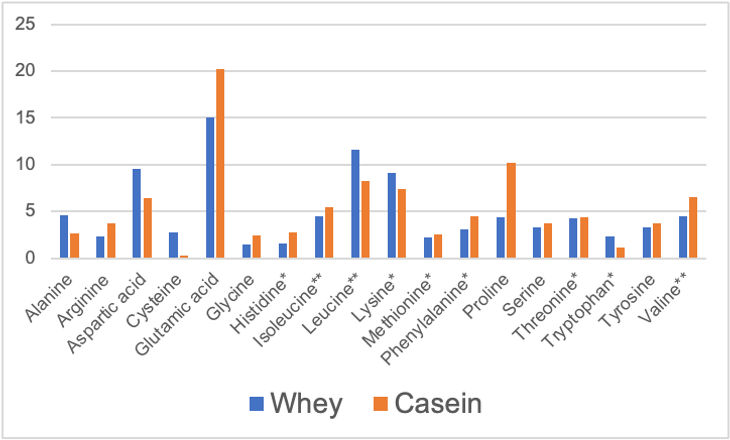
Plant-based protein powders also tend to be excellent protein sources in terms of their amino acid profiles. To learn more, check out my articles on soy and pea proteins, brown rice and pea proteins, hemp and pea proteins, and hemp and whey proteins.
Protein Bars
Most milk-based protein bars contain whey protein, which provides a wide range of amino acids (see Figure 1 above). Among other proteins, the plant-based protein bars in Table 5 above all contain pea and/or soy proteins, which also have very good amino acid profiles (2).
Figure 2
Grams of Essential Amino Acid in 100 Grams of Pea Protein and Soy Protein
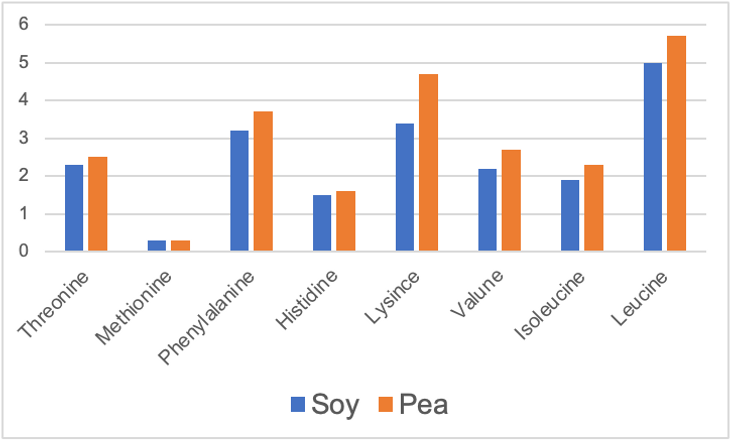
Protein Powder and Bars for Muscle Growth
Among protein supplements, whey protein powder has been researched more than any other.
As discussed in my articles comparing whey and creatine, whey and mass gainers, and whey and eggs (including yolks and egg whites), there's extensive scientific evidence that whey protein powder can facilitate increases in muscle mass. Similarly, my articles on vegan protein powders (see links in the previous section) present evidence that soy, pea, hemp, and rice proteins can all contribute to muscle gain.
As mentioned above, most protein bars contain whey protein or a mix of plant-based proteins, so it's highly likely that these, too, can promote muscle growth.
You might like to check out my articles on whey, soy, and pea proteins and plant-based proteins and whey protein for bodybuilding.
Protein Powder and Bars for Muscle Repair
It's well-established in the scientific literature that protein powders can facilitate muscle repair.
For example, one study published in Nutrients (3) found that whey protein ingestion post-exercise reduces protein breakdown and can improve maximal strength, repetitions to failure, and peak power at 24 hours post-exercise. These findings suggest that whey protein effectively supports muscle repair and recovery, enhancing exercise performance after resistance training.
Consistent with this, there's also evidence that protein bars can promote post-exercise recovery (4).
Protein Powder and Bars for Weight Loss
Check out my article on the best protein powders for weight loss if you're interested in how protein powders and bars can help improve your body composition.
In short, if you want to reduce your calorie intake while still getting a lot of protein, the best option I've come across is Myprotein's Impact Casein Powder, which has just 350 calories per 100 grams (about three scoops) while still packing 82 grams of protein. Among plant-based options, your best choice is probably Myprotein's Soy Protein Isolate, which, per 100 grams, has 360 calories and 90 grams of protein.
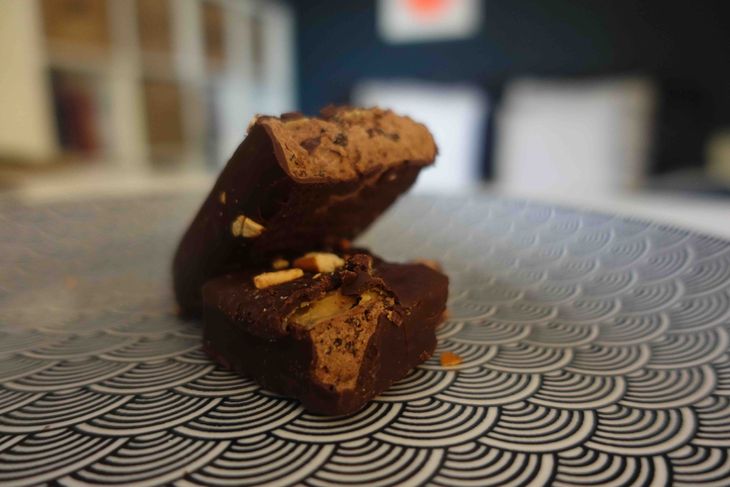
Myprotein's Vegan Carb Crusher. I made a quick note when I tried this: "Quite chewy, with a bit of a crunch. Good, but quite sweet."
In my opinion, the best protein bars for losing weight include Myprotein's Crispy Layered Bar (353 calories and 27 grams of protein per 100 grams) and Grenade's Chocolate Chip Cookie Dough Bar (353 calories and 34 grams of protein per 100 grams). If you'd like a plant-based protein bar for weight loss, I'd go for Myprotein's Vegan Carb Crusher (394 calories and 27 grams of protein per 100 grams).
Artificial Sweeteners and Added Sugar in Protein Powder and Bars
Most flavoured protein powders and bars contain artificial sweeteners (e.g., sucralose), which sometimes include sugar alcohols (e.g., Maltitol). If you'd like to avoid these, you could opt for an unflavoured protein powder, though these tend to taste bad, so you might need to find a way of combining them with ingredients you enjoy (e.g., include them in a banana smoothie). You can find protein bars without artificial sweeteners and that only use natural ingredients (e.g., those by Go Macro), but these do usually have more sugar.
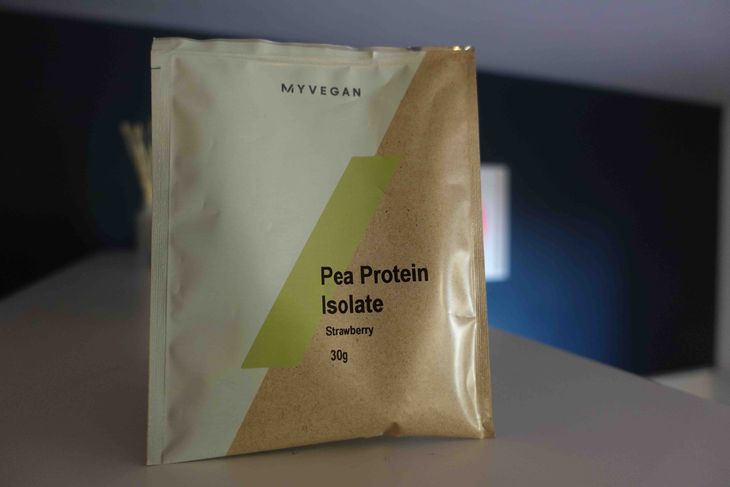
A sample of Myprotein's Pea Protein Isolate. You can often get samples like this on Myprotein for less than a pound. I've only tried the strawberry flavour so far, which was surprisingly good. The amount of sugar varies depending on the flavour, but most of Myprotein's pea isolate protein powders have less than 1 gram per 100 grams.
The good news is most protein powders and bars don't have much sugar. As shown in Table 1 in my article on the best protein supplements for diabetics, protein powders tend to have between 0.5 (e.g., Myprotein's Soy Protein Isolate) and 5 (e.g., Pure Hemp 50) grams of sugar per 100 grams.

Myprotein's Layered Bar has just 3.2 grams of sugar per 100 grams (1.9 grams per bar). My note to myself when I tried it: "Good (chewy, crispy), but very sweet." It's a well-crafted protein bar in terms of its texture and macronutrient balance (33 grams of protein, 34 grams of carbs, and 10 grams of fats per 100 grams), but you'll need a sweet tooth to enjoy it.
Myprotein's milk-based protein bars tend to have just 3–5 grams of sugar per 100 grams (see Table 3 above), though the sugar content in their plant-based bars is more varied, from 3 just grams in their Vegan Carb Crusher to 17 grams in their Pea-Nut Square per 100 grams (see Table 5 above). Grenade's milk-based protein bars tend to contain just 1–3 grams of sugar per 100 grams, so these are good options if you're looking to reduce your sugar intake. Alternatively, if you're interested in granola bars (i.e., something that combines oats and honey or syrup) as you'd like to increase your carb intake, you could check out Myprotein's oat flapjacks.
Protein Powder and Bars: Which is More Convenient?
Protein powders and bars are both very convenient sources of protein.
Protein powder can be used in many ways. As mentioned in the intro, I use it not only to make shakes but also in smoothies, pancakes, porridge, and cereal. If you enjoy baking, you could also use it to make cookies, biscuits, or protein balls, and in countless other ways. While I consume more protein powder as it's a leaner source of protein, bars are a more convenient option as they require zero preparation, there's nothing to clean after, and there's little risk of making a mess in your gym bag.
If convenience is a priority for you, you could also consider Grenade's ready-made protein shakes, which have about 25 grams of protein per 330-ml bottle.
Whole Food Sources of Protein
Although supplements can help you meet your daily protein needs, you should also aim to increase your protein levels through whole foods, which contain important micronutrients that supplements lack.
For example, lean meats and fish are often good sources of protein. If you're on a vegan diet, check out our article about vegan protein snacks.
Nut butters are also a convenient source of protein, have lots of healthy fats (5), and are a good choice for those aiming for a higher calorie count to increase their mass (see Table 6 below).
Table 6
Comparison of Myprotein's Nut Butters With Respect to Their Calories and Macronutrients per 100 Grams
| Nut Butter Type | Calories | Protein | Carbs | Fats |
|---|---|---|---|---|
| All-Natural Peanut Butter | 615 | 30 | 12 | 48 |
| All-Natural Almond Butter | 644 | 24 | 6.4 | 57 |
| All-Natural Cashew Butter | 637 | 20 | 18 | 53 |
| All-Natural Triple Nut Butter | 622 | 25 | 13 | 50 |
If you're unable to eat solid food (e.g., when travelling), you could occasionally substitute with meal replacements. For instance, Myprotein's meal replacement is fortified with a wide range of vitamins and minerals and has 34 grams of protein per 100 grams.
Conclusion
Pros and Cons of Protein Bars
As discussed, the benefits of protein bars relative to protein powder mainly relate to their convenience. Compared to sweets or chocolate, they represent quite a healthy snack as they're usually high in protein and low in sugar, which is good if you want to avoid weight gain.
The cons of protein bars primarily relate to their having far less protein per gram than protein powders. Also, if you want to avoid artificial sweeteners, this may mean choosing a bar with high sugar content.
Lastly, in terms of their nutritional value, many protein bars provide little in the way of micronutrients, but this isn't necessarily a problem so long as your diet also contains whole food ingredients.
Pros and Cons of Protein Powders
Regarding the benefits of protein powders, they can be amazing if you want to add an extra boost of protein to the foods you may already eat (e.g., cereal, porridge, smoothies, pancakes).
As they're a leaner source of protein compared to bars, protein powders are likely the better choice for those who want to follow a diet plan that includes a lot of protein without too many calories. Additionally, as they come in so many flavours (Myprotein's Impact Whey Protein Powder is currently available in about 30 flavours), there's something to suit all taste preferences. As with protein bars, protein powders are excellent for those with a busy schedule who cannot spend hours cooking protein-rich, healthy foods every day (without the budget for a personal chef, we can't all eat like Mark Wahlberg). While it is important to eat a balanced diet to meet your nutritional needs and look after your overall health, a quick protein shake is a great way of increasing your protein intake within just a minute or two.
In terms of their cons, protein powders can be a little messier than protein bars and, like bars, their nutritional content is limited in terms of nutrients other than amino acids—but that's why they're called supplements.
Combining Protein Bars and Powders
Of course, you don't need to choose between protein bars and powders—this isn't Sophie's Choice. I think of protein bars and protein powders as being optimal for different scenarios. At home, I usually use protein powder as it's a leaner and cheaper source of protein. However, if I'm on a plane or train and getting my protein in liquid form may cause a mess or attract attention, I'll go for a bar instead.
About the Author
Dave Robinson, a co-founder of ukfitness.pro, has a background in psychology (BSc) and neuroscience (MSc, PhD). As well as strength training, he enjoys endurance challenges and has run ultramarathons, cycled across several countries, and completed the Three Peaks Challenge. When writing, he draws on scientific evidence to understand the pros and cons of different diets, supplements, and training regimes.

References
1. Rasmussen, C.J. (2008). Nutritional Supplements for Endurance Athletes. In: Nutritional Supplements in Sports and Exercise. Humana Press. https://doi.org/10.1007/978-1-59745-231-1_11
2. Gorissen, S. H. M., Crombag, J. J. R., Senden, J. M. G., Waterval, W. A. H., Bierau, J., Verdijk, L. B., & van Loon, L. J. C. (2018). Protein content and amino acid composition of commercially available plant-based protein isolates. Amino acids, 50(12), 1685–1695. https://doi.org/10.1007/s00726-018-2640-5
3. West, D. W. D., Abou Sawan, S., Mazzulla, M., Williamson, E., & Moore, D. R. (2017). Whey Protein Supplementation Enhances Whole Body Protein Metabolism and Performance Recovery after Resistance Exercise: A Double-Blind Crossover Study. Nutrients, 9(7), 735. https://doi.org/10.3390/nu9070735
4. Grubic, T. J. (2018). Effects of Consuming a Food Bar Containing Whey Protein and Isomalto-Oliosaccharides on Glucose Homeostasis, Exercise Performance and Recovery [Doctoral dissertation, Texas A&M University]. Available electronically from https://hdl.handle.net/1969.1/174558
5. Ros, E., & Mataix, J. (2006). Fatty acid composition of nuts--implications for cardiovascular health. The British journal of nutrition, 96 Suppl 2, S29–S35. https://doi.org/10.1017/bjn20061861